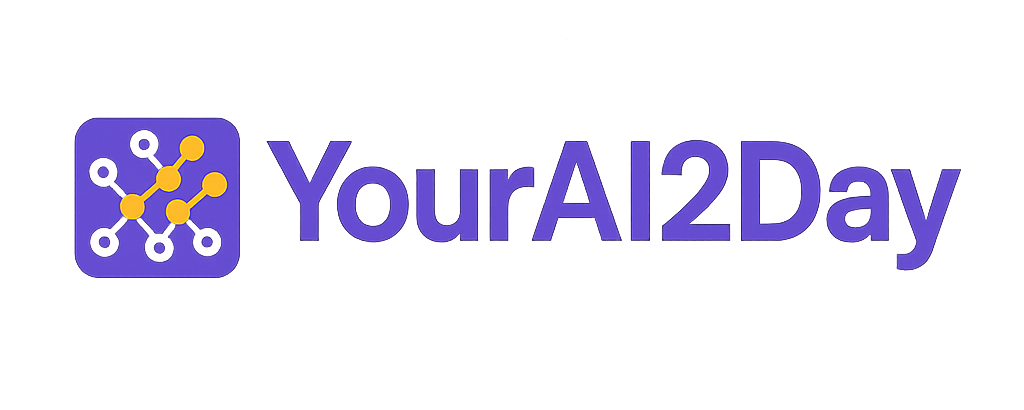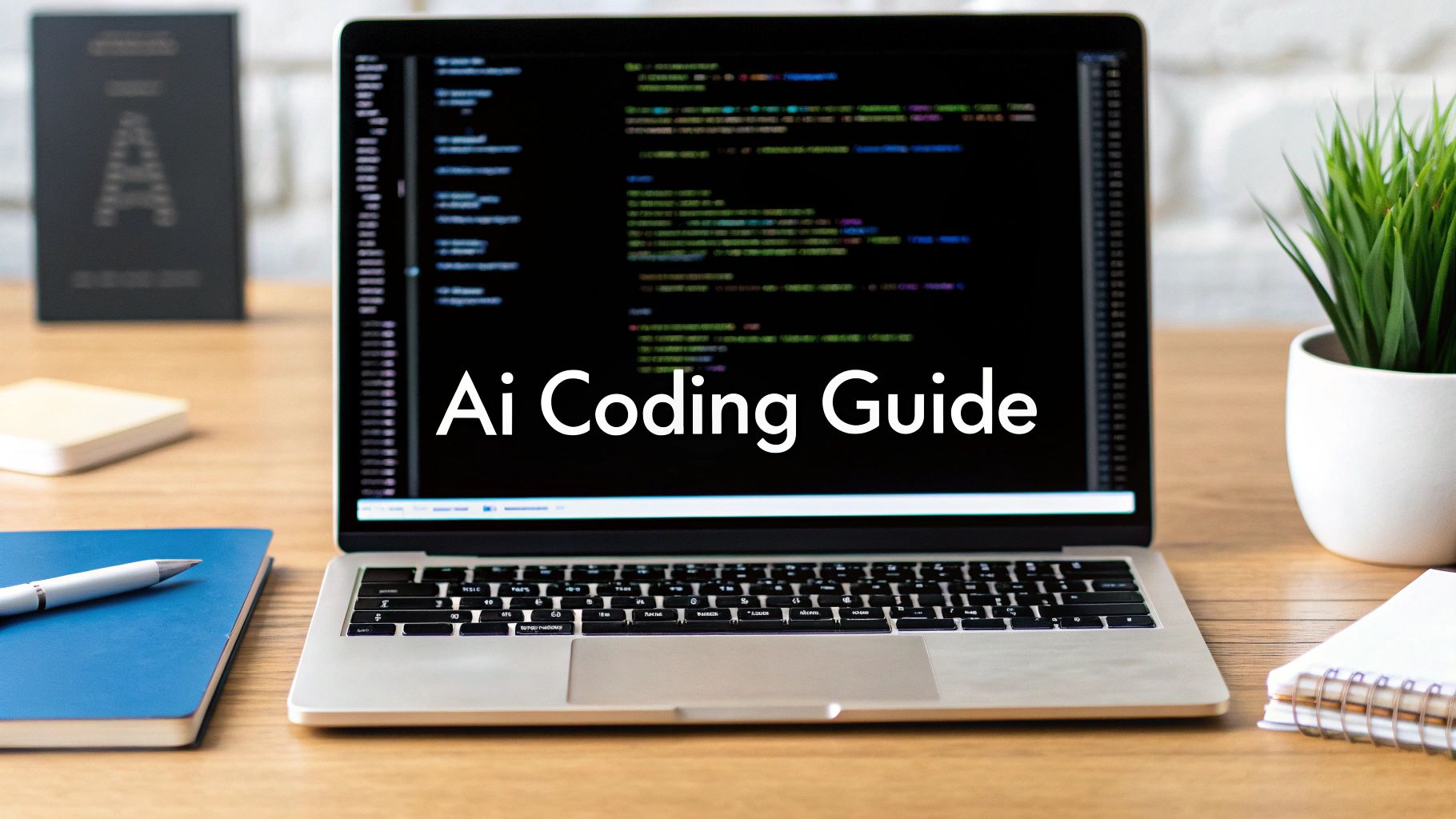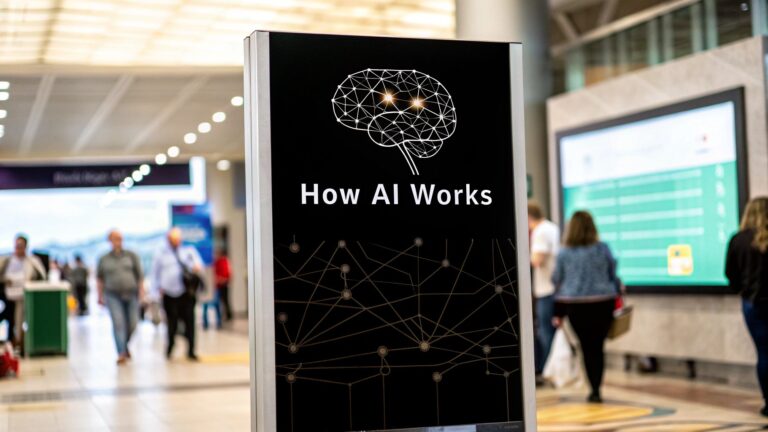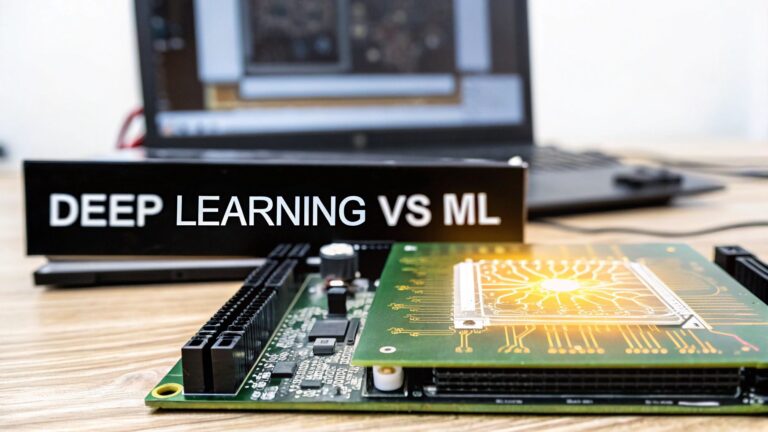A Friendly Guide to AI for Code
Picture this: you've got a brilliant coding partner working alongside you, one that never sleeps. It suggests the next line of code, catches your typos before they become bugs, and handles all the boring, repetitive tasks. Sound good? That's the reality of AI for code. It’s not here to replace developers, but to give us all a ridiculously powerful new tool.
What is AI for Code, Really?
Ever find yourself stuck writing the same boilerplate functions over and over? Or staring at a wall of text, trying to find that one misplaced semicolon? That's exactly where AI coding assistants come in to play. They're designed to be your trusted sidekick, a smart helper right inside your code editor that understands what you're trying to do and helps you get there faster.
This isn't some far-off concept; it’s a practical tool that millions of developers, from beginners to seasoned pros, rely on every single day to write better code.
I like to think of it as a GPS for programming. A GPS doesn't drive your car for you, but it sure makes the trip easier. It shows you the fastest routes (efficient code), warns you about traffic jams (potential bugs), and helps you get to your destination (a finished project) with way less stress. AI coding tools do the same thing for software development.
An Assistant, Not an Autopilot
One of the first questions people ask is, "Will these tools make programmers obsolete?" The answer from experts across the board is a resounding "no." Think of it this way: these tools take the grunt work off your plate, freeing you up to focus on the things that actually require human ingenuity.
Experienced developer Miguel Grinberg puts it perfectly. He points out that while AI can write code, a human developer is always the one who has to review it, understand it, and ultimately take responsibility for it.
"I'm always the responsible party for the code I produce, with or without AI… I could only incorporate AI generated code into a project of mine after I thoroughly review it and make sure I understand it well."
This partnership lets you zero in on what really matters:
- Creative Problem-Solving: You get to spend more brainpower on the big picture, like designing your application's architecture and core logic.
- Learning New Skills: AI suggestions can act like a real-time tutor, helping you grasp new languages or frameworks as you go.
- True Innovation: Instead of getting bogged down in boilerplate, you can focus your energy on building the unique, standout features of your project.
In the end, using AI for code is about making you a better, more efficient developer. It's a tool that amplifies your own skills, boosting both your productivity and your creativity.
To get a clearer picture, let's break down what these AI assistants actually do for you day-to-day.
How AI Coding Assistants Help You
Here's a quick look at the core functions of AI tools for programmers.
| Feature | What It Does for You | A Practical Example |
|---|---|---|
| Code Completion | Suggests entire lines or blocks of code as you type, saving you from repetitive work. | You type const user = and the AI suggests await getUserById(id);. |
| Bug Detection | Scans your code in real-time to spot errors, logical flaws, and security vulnerabilities. | It highlights a variable you're using before you've defined it. |
| Code Refactoring | Helps you clean up, optimize, and improve the readability of your existing code. | You highlight a messy for loop and ask it to convert it into a cleaner .map() function. |
| Natural Language to Code | Translates a plain English description into working code. | You type a comment: # function to validate an email address with regex and it generates the full function. |
| Unit Test Generation | Automatically writes tests for your functions, ensuring your code is reliable. | You right-click a function and select "Generate unit tests," and it creates a test file with several cases. |
| Code Documentation | Generates comments and documentation to explain what your code does. | It adds a detailed docstring above your function explaining its parameters, what it does, and what it returns. |
As you can see, these features are designed to handle the most time-consuming parts of programming, letting you focus on the creative and strategic aspects of building software.
How AI Actually Understands and Writes Code
So, how can an AI take a simple English request and spit out working, human-readable code? It might feel like magic, but what’s happening under the hood is a fascinating process built on a technology called a Large Language Model (LLM). This is a type of AI that has been trained on an almost unimaginable amount of text and code.
Think of it like a digital apprentice who has spent years devouring every programming book, every line of code on GitHub, and every technical forum post on the internet. This isn't just rote memorization. The LLM has learned to recognize the deep patterns, syntax, and logical flows that define different programming languages. This contextual understanding is the secret sauce.
When you ask an AI coding assistant to write a function, it isn't just pulling a snippet from a database. It’s using its training to predict the most logical and effective sequence of code that matches your request. It’s a bit like having a conversation with an expert who can instantly connect your goal to the precise syntax needed to achieve it.
The Brain Behind the Operation
At the core of an LLM are billions of adjustable "knobs" called parameters. As the model trains on countless code examples, it fine-tunes these parameters to learn the complex relationships between words, symbols, and programming concepts.
The foundational architecture for most of these models is the transformer, which is what allows the AI to grasp context over long stretches of text and code.
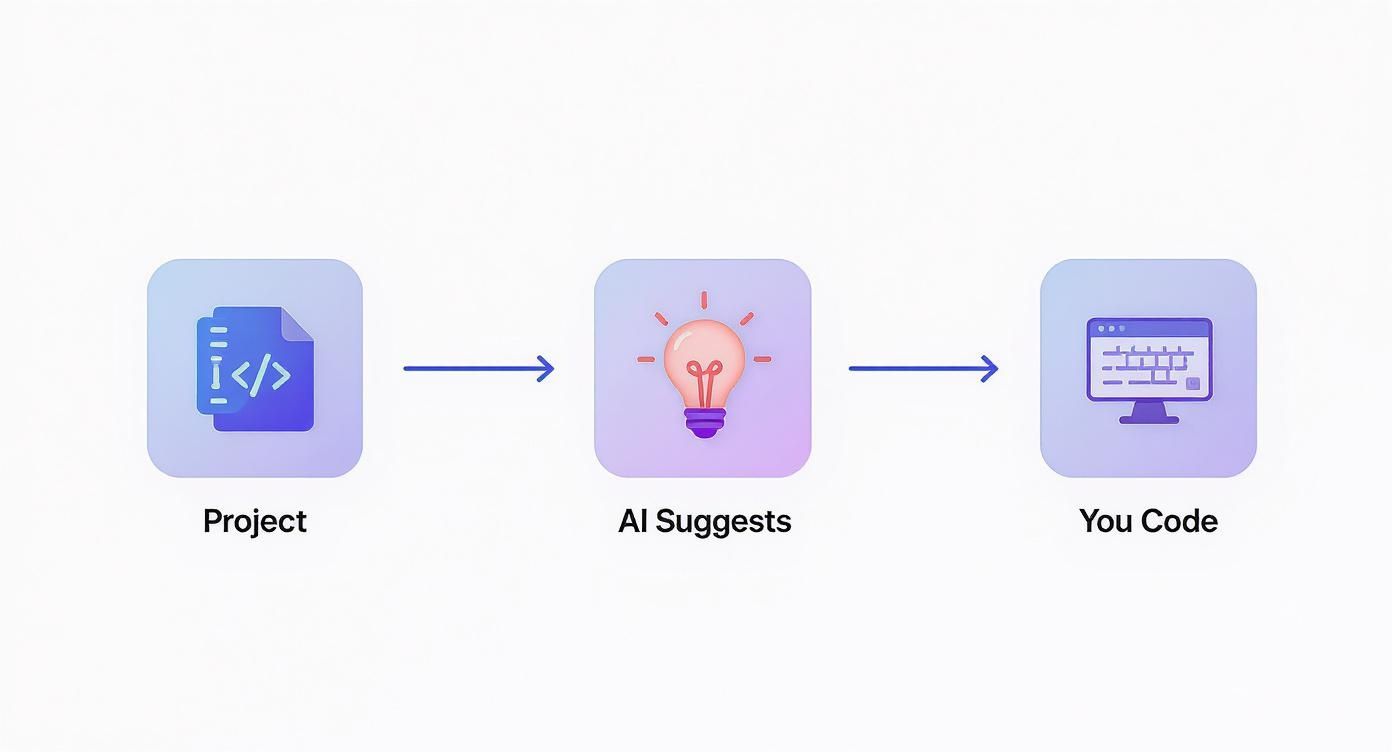
This structure is what lets the AI weigh the importance of different parts of your prompt and generate something coherent and relevant. It’s the difference between a basic autocomplete and a genuine coding partner.
The effect of this technology is already staggering. Recent data reveals that AI systems are now responsible for generating 41% of all code written worldwide. On top of that, 82% of professional developers are using AI coding tools weekly, often running multiple assistants at once to streamline their workflow.
From Your Prompt to a Working Program
What does this collaboration look like in practice? It’s really a continuous feedback loop between you and the AI.
The process is a simple, powerful cycle: you provide the direction, the AI generates the code, and you review, test, and refine it. This back-and-forth makes development work incredibly dynamic and efficient.
AI-powered coding really shines in a few key areas:
- Code Generation: You can describe what you need in plain language—"write a Python function to parse a CSV file and return a dictionary"—and the AI will generate the code.
- Code Completion: As you start typing, the AI anticipates your next move, suggesting anything from the rest of a line to an entire multi-line block.
- Refactoring: If you have a block of messy or inefficient code, you can ask the AI to clean it up or optimize it for better performance.
By grasping these core mechanics, you get a much better sense of how to program artificial intelligence to become an extension of your own skills. It’s all about leveraging its ability to recognize patterns at a scale no human ever could.
Top AI Coding Tools You Can Use Today
Ready to give AI coding a try? The market is buzzing with options, but a few tools have clearly risen to the top thanks to their power, elegant design, and massive developer communities. Let's break down the main players you'll want to get your hands on.
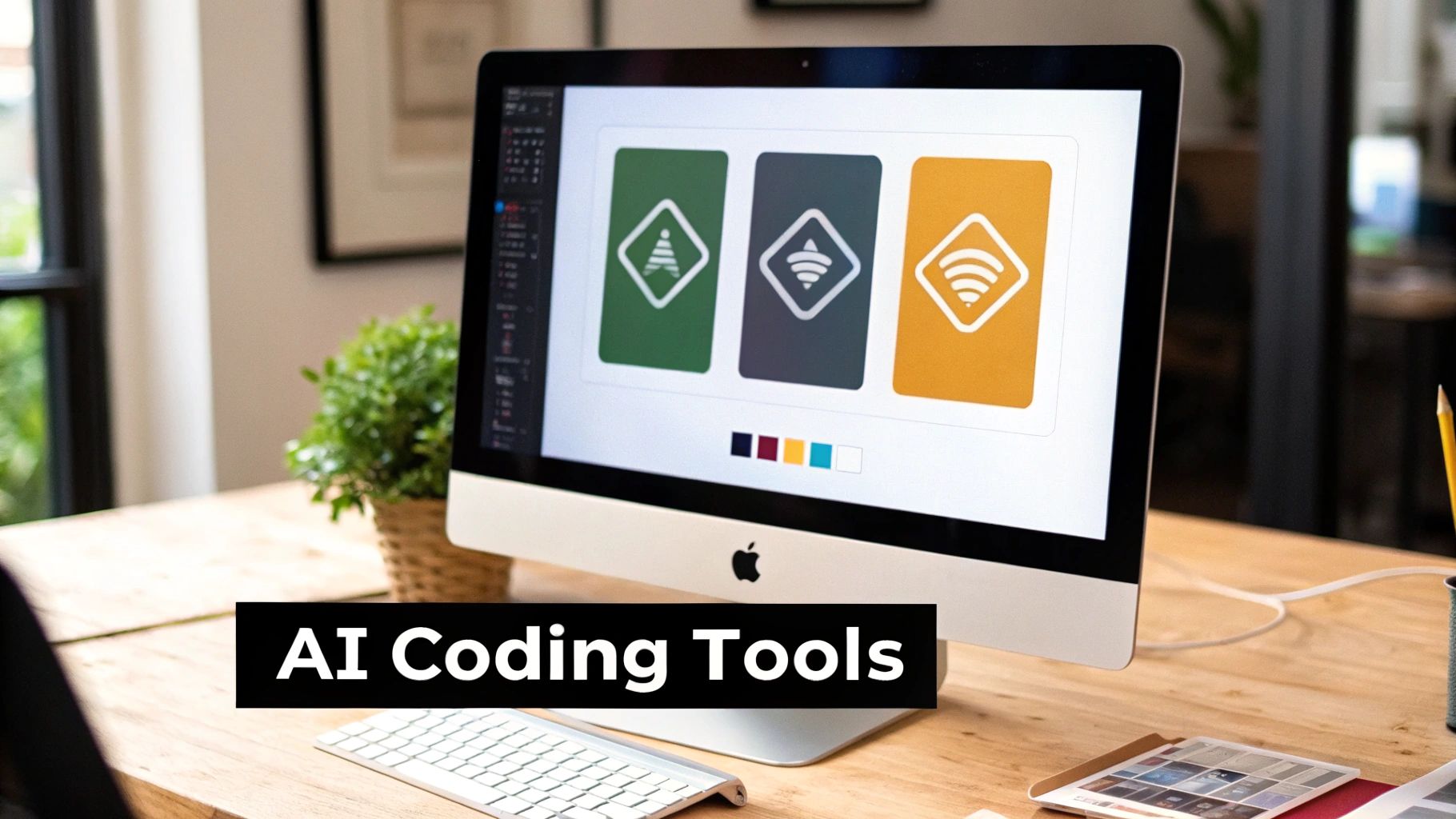
This is a perfect example of what it feels like to use a tool like GitHub Copilot. It's not a separate window or a clunky app; it works right inside your editor, offering up code blocks as if your computer is reading your mind. It’s a seamless part of the daily workflow.
GitHub Copilot: The Industry Standard
When developers talk about AI coding assistants, GitHub Copilot is almost always the first name mentioned. It’s built on OpenAI's incredibly powerful models and has been trained on a massive amount of public code from GitHub repositories. This makes it the default choice for millions, from solo coders to entire enterprise teams.
Copilot’s magic is its deep integration. It slots directly into popular editors like Visual Studio Code and just works. As you type, it analyzes your comments, function names, and surrounding code to offer suggestions that are often shockingly accurate.
For instance, you could be in a Python file and write a simple comment: # function to fetch user data from an API and parse it. Before you can even start typing def, Copilot will likely suggest the entire function—complete with the API call, error handling, and JSON parsing. It's a huge time-saver for all that boilerplate code.
Tabnine: Privacy and Personalization
Copilot is a powerhouse, but sending proprietary code to a third-party server is a non-starter for many companies. That’s where Tabnine has carved out its niche. It delivers a similar AI-powered experience but with a major focus on privacy, even allowing teams to host the model on their own infrastructure.
Tabnine’s other big win is personalization. It can learn from your team's private codebase, picking up on your specific conventions, architectural patterns, and internal libraries. Over time, its suggestions start to feel less like generic advice and more like a senior dev on your team is guiding you.
As one expert developer noted, “The best AI tools are the ones that adapt to your specific context.” A tool that understands your project’s unique patterns is far more valuable than one offering generic advice.
This makes it the go-to for organizations that need AI assistance without compromising on security or their established coding standards.
Amazon CodeWhisperer: The AWS Specialist
If you live and breathe Amazon Web Services, then Amazon CodeWhisperer should be at the top of your list. It’s a solid general-purpose assistant, but its real advantage is its native understanding of the entire AWS ecosystem.
Need to write a Lambda function that interacts with an S3 bucket and a DynamoDB table? CodeWhisperer knows the exact SDK calls, permissions, and best practices to suggest. It even has built-in security scanning to catch common vulnerabilities when you're working with AWS resources, which is a massive bonus for anyone building on the cloud.
Comparing Popular AI Coding Assistants
Choosing the right tool can feel overwhelming, but it really comes down to what you value most. This table breaks down the core strengths of each to help you decide.
| Tool | Best For | Key Feature |
|---|---|---|
| GitHub Copilot | General-purpose coding and rapid prototyping | Deep IDE integration and powerful suggestions |
| Tabnine | Teams with strict privacy or style needs | Self-hosting options and personalization from your code |
| Amazon CodeWhisperer | Developers building on the AWS cloud | AWS service optimization and integrated security scans |
Ultimately, there's no single "best" tool—only the one that's best for you. Whether you need raw power, tight security, or cloud-specific expertise, there's an AI assistant ready to help.
For a deeper dive into more options and features, check out our complete guide to the best AI coding assistants to find the perfect match for your workflow.
Real-World Benefits of Coding with AI
So, what’s the real story behind developers flocking to AI for code? It’s not just about getting things done faster. The real appeal is how it’s changing the very nature of development, freeing us up from the daily grind to focus on the problems that actually require our creativity. These tools are quickly becoming indispensable partners in the coding process.
The most obvious win is the time saved on boilerplate code. We’ve all been there—setting up a new project, writing another config file, or scaffolding a basic API endpoint. An AI assistant can knock out these necessary but mind-numbing tasks in seconds, letting you dive right into the heart of the project.
Accelerating Productivity and Innovation
This isn't about saving a few minutes; it's about reclaiming huge chunks of your workday. A recent analysis really puts this into perspective. Over 80% of enterprises globally are already using generative AI in their workflows, showing that this has gone from a niche experiment to a core business tool.
This massive adoption has cut the average return on investment for AI code generation tools from 12.7 months down to just 6 months. That’s a clear signal of how quickly these tools start paying for themselves. You can discover more insights about the rapid adoption of AI coding tools and see how they are reshaping development cycles.
By handing off the routine work to AI, developers can concentrate on more complex challenges. Instead of getting stuck in the weeds of syntax and setup, your mental energy is spent designing better architecture, improving the user experience, or coming up with your next big feature.
One senior developer summed it up perfectly:
"Integrating AI tools has transformed our workflow. It's like having a junior dev handle the routine tasks, which allows my team to focus on high-level architecture and creativity."
A Powerful Learning Companion
Productivity aside, AI is an amazing learning tool, especially if you're just starting out. Stuck on a tricky function or not sure how to use a new library? Just ask your AI assistant for an example, right inside your code editor. It gives you instant, relevant code snippets you can learn from and adapt.
For a beginner, this is a game-changer. Let's say you're learning JavaScript and can't remember how to fetch data from an API. You could type a comment like // fetch user data from jsonplaceholder and your AI assistant will likely write out the entire fetch() call for you, complete with .then() blocks or async/await. You get a working example instantly.
This creates a powerful real-time feedback loop for building skills. You spend less time digging through forums and documentation and more time understanding concepts as you apply them, which drastically shortens the learning curve for new languages and frameworks.
Improving Overall Code Quality
Finally, using AI for coding often leads to better, more consistent code. These models are trained on massive amounts of high-quality, open-source code, so the suggestions they offer usually align with established best practices. They can guide you toward writing cleaner and more efficient code without you having to be a walking encyclopedia of style guides.
Many AI assistants also proactively flag potential bugs and suggest fixes before you even run your code. It's like having a second set of eyes on your work, catching simple mistakes before they snowball into bigger headaches. This built-in quality check saves a ton of time on debugging down the road.
Navigating AI Challenges and Limitations
The hype around using AI for code is huge, but it's important to step back and look at these tools with a critical eye. They're incredible assistants, no doubt, but they are far from infallible. If you jump in expecting flawless code on demand, you're setting yourself up for a world of frustration—and you might even create more problems than you solve.

Perhaps the single biggest hurdle is what I call the "confidently incorrect" problem. An AI assistant can spit out a block of code that looks perfect. The syntax is clean, it seems to follow your prompt to the letter, but lurking just beneath the surface is a subtle logic bomb or a call to a deprecated function that will cause a headache later.
This is precisely why human oversight isn't just a good idea; it's non-negotiable. An observational study on experienced developers using AI tools found something fascinating: in some cases, developers actually took longer to finish a task with AI's help. Why? They were spending so much time tracking down and fixing the plausible-sounding but fundamentally broken code the AI produced. You can read the full research on AI's impact on developer productivity to see the data for yourself.
The Critical Role of Human Oversight
The golden rule here is to treat your AI assistant as a co-pilot, not the pilot. You are still in the captain's chair, and you are always responsible for the quality, safety, and performance of the code that gets shipped. Blindly accepting every suggestion is a direct path to technical debt and brittle software.
The best approach is to adopt a "trust, but verify" mindset. Think of the AI's output as a first draft or a solid starting point, never the finished product. This lets you tap into the speed and efficiency of the tool without ever giving up control.
Expert Opinion: Treat AI-generated code like a pull request from a brand-new junior developer. You'd never merge it without a deep, critical review, right? The same rigorous standard has to apply here. It's on you to understand, test, and ultimately own every single line.
Practical Tips for Safe AI Coding
Developing a few smart habits can help you sidestep the common traps and use AI for code responsibly. These practices are all about catching issues early and keeping your project’s quality bar high.
- Review Every Single Suggestion: Before you hit "accept," actually read the code. Does it make logical sense? Does it fit into your project's existing architecture and coding standards?
- Be Relentless with Testing: Always write and run thorough unit tests for any logic the AI generates. This is your best defense to prove the code does what you think it does under all sorts of conditions.
- Put on Your Security Hat: AI models can unintentionally introduce code with known security holes. You need to stay sharp on common vulnerabilities and scan for them in the generated code. A great place to start is by brushing up on AI security best practices.
- Understand, Don’t Just Copy-Paste: If an AI gives you a clever one-liner or a complex function you don't fully grasp, stop. Take a minute to figure out exactly what it's doing. Not only will this prevent future bugs, but it also transforms the tool from a simple code generator into a powerful learning companion.
Got Questions About AI for Code? We've Got Answers.
As you start looking into AI coding tools, it’s completely normal to have some questions pop up. It’s a new frontier for many of us, and there's a lot to wrap your head around. This section tackles the big questions we hear most often, giving you clear, direct answers so you can move forward with confidence.
Think of this as your quick-start guide to the bigger picture. We’ll get into the future of the developer role, how to actually start using these tools, and the all-important topic of data privacy.
Will AI Replace Programmers?
The short answer is a firm no. What it will do is change the job. AI is a fantastic sidekick for handling repetitive, low-level work—things like writing boilerplate code, suggesting entire functions, and catching simple syntax mistakes. It’s an assistant that clears the tedious stuff off your desk.
But here’s the thing: AI can’t do what makes a great developer truly great. It doesn't understand nuanced business needs, it can’t think critically about architectural trade-offs, and it certainly can’t dream up a genuinely new solution to a complex problem. Those are human skills, through and through.
The future of programming isn’t about being replaced; it's about collaboration. Developers who learn to work with AI for code will become far more productive and valuable. They'll be free to focus their brainpower on creative, high-level problem-solving while their AI partner handles the grunt work.
How Do I Get Started with an AI Coding Assistant?
Jumping in is much easier than you might think. Most of the best tools, like GitHub Copilot or Tabnine, are built to plug directly into the code editors you already know and love, like VS Code.
Here's a simple breakdown of the steps:
- Choose Your Tool: Based on what we've covered, pick the assistant that seems like the best fit for you.
- Sign Up: Head over to the tool's official website. Many offer a free trial, which is a perfect way to test the waters without any commitment.
- Install the Extension: Pop open your code editor's extension marketplace, search for the tool, and click install.
- Activate and Go: Log in, and the AI will immediately start offering suggestions right as you type.
A pro tip for anyone just starting out: begin with a personal or practice project. It’s a great, low-pressure way to get a feel for how the AI thinks and responds before bringing it into your professional workflow.
Is My Code Safe When Using AI Tools?
This is a huge and very valid concern. The answer really boils down to which tool and which specific plan you're using. With most cloud-based AI assistants, small snippets of your code get sent to the company’s servers to generate suggestions. While the big names in the space have solid privacy policies, this can be a non-starter for anyone working on sensitive or proprietary code.
For professional development, you'll want to look for tools that offer enterprise-grade privacy protections. GitHub Copilot for Business, for instance, is built to guarantee your code is never used to train their public models. Some tools, like Tabnine, even let you run the model on-premise, keeping everything securely inside your own network.
Before you commit, always review the tool's privacy policy. Taking a few minutes to understand exactly how your data is treated is the best way to use these powerful tools without putting your security at risk.
Ready to explore the world of artificial intelligence further? At YourAI2Day, we provide the latest news, in-depth guides, and practical tools to help you understand and apply AI. Visit us at https://www.yourai2day.com to stay informed.
